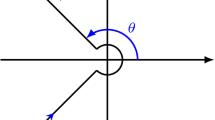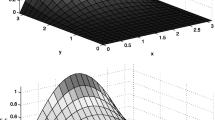Abstract
The solution of the nonlinear subdiffusion equation has the initial layer and its initial energy may decay very fast. Therefore, it is important to investigate the evolution of the solution at the beginning. In the paper, a transformed L1 scheme is proposed to capture the initial dramatic evolution. It is proved that the temporal error of the new method is \({\mathcal {O}}(\tau ^{2-\alpha })\), where \(\tau \) is the temporal stepsize and \(0<\alpha <1\). The error estimate holds even when \(t\rightarrow 0\). In contrast, the maximum errors of the uniform L1 scheme, the convolution quadrature (CQ) Euler method, CQ BDF method, and their corrected forms are usually \({\mathcal {O}}(\tau ^{\alpha })\) at the beginning. Meanwhile, the proposed time discretization is particularly effective for models with the small \(\alpha \) and their interesting numerical phenomena are reported for the first time. Finally, numerical comparison are provided with widely used L1-type methods, the CQ methods, and their corrected forms.






Similar content being viewed by others
References
Azevedo, E.N., de Sousa, P.L., de Souza, R.E., Engelsberg, M., Miranda, M., Silva, M.A.: Concentration-dependent diffusivity and anomalous diffusion: a magnetic resonance imaging study of water ingress in porous zeolite. Phys. Rev. E 73, 011204 (2006)
Chen, Y., Tang, T.: Convergence analysis of the Jacobi spectral-collocation methods for Volterra integral equations with a weakly singular kernel. Math. Comput. 79, 147–167 (2010)
Chepizhko, O., Peruani, F.: Diffusion, subdiffusion, and trapping of active particles in geterogeneous media. Phys. Rev. Lett. 111, 160604 (2013)
Cao, W., Zeng, F., Zhang, Z., Karniadakis, G.E.: Implicit-explicit difference schemes for nonlinear fractional differential equations with nonsmooth solutions. SIAM J. Sci. Comput. 38(5), A3070–A3093 (2016)
Diethelm, K., Ford, N.J., Freed, A.D.: Detailed error analysis for a fractional Adams method. Numer. Algorithms 36, 31–52 (2004)
El Abd, A.E.-G., Milczarek, J.J.: Neutron radiography study of water absorption in porous building materials: anomalous diffusion analysis. J. Phys. D Appl. Phys. 37, 2305 (2004)
Gracia, J.L., O’Riordan, E., Stynes, M.: A fitted scheme for a Caputo initial-boundary value problem. J. Sci. Comput. 76, 583–609 (2018)
Inc, M., Yusuf, A., Aliyu, A., Baleanu, D.: Time-fractional Cahn–Allen and time-fractional Klein–Gordon equations: Lie symmetry analysis, explicit solutions and convergence analysis. Phys. A Stat. Mech. Appl. 493, 94–106 (2018)
Kopteva, N.: Error analysis of the L1 method on graded and uniform meshes for a fractional-derivative problem in two and three dimensions. Math. Comput. 88, 2135–2155 (2019)
Küntz, M., Lavallée, P.: Experimental evidence and theoretical analysis of anomalous diffusion during water infiltration in porous building materials. J. Phys. D Appl. Phys. 34, 2547 (2001)
Jin, B., Li, B., Zhou, Z.: Numerical analysis of nonlinear subdiffusion equations. SIAM J. Numer. Anal. 56(1), 1–23 (2018)
Jin, B., Li, B., Zhou, Z.: Correction of high-order BDF convolution quadrature for fractional evolution equations. SIAM J. Sci. Comput. 39(6), A2129–A3152 (2017)
Kolk, M., Pedas, A., Tamme, E.: Modified spline collocation for linear fractional differential equations. J. Comput. Appl. Math. 283, 28–40 (2015)
Kolk, M., Pedas, A., Tamme, E.: Smoothing transformation and spline collocation for linear fractional boundary value problems. Appl. Math. Comput. 283, 234–250 (2016)
Li, B., Wang, H., Wang, J.: Well-posedness and numerical approximation of a fractional diffusion equation with a nonlinear variable order. ESAIM Math. Model. Numer. Anal. 55, 171–207 (2021)
Li, D., Sun, W., Wu, C.: A novel numerical approach to time-fractional parabolic equations with nonsmooth solutions. Numer. Math. Theor. Meth. Appl. 14, 355–376 (2021)
Li, D., Wang, J., Zhang, J.: Unconditionally convergent L1-Galerkin FEMs for nonlinear time-fractional Schrö dinger equations. SIAM J. Sci. Comput. 39, A3067–A3088 (2017)
Li, D., Wu, C., Zhang, Z.: Linearized Galerkin FEMs for nonlinear time fractional parabolic problems with non\(-\)smooth solutions in time direction. J. Sci. Comput. 80, 403–419 (2019)
Li, D., Zhang, C.: Long time numerical behaviors of fractional pantograph equations. Math. Comput. Simul. 172, 244–257 (2020)
Li, Z., Wang, H., Yang, D.: A space-time fractional phase-field model with tunable sharpness and decay behavior and its efficient numerical simulation. J. Comput. Phys. 347, 20–38 (2017)
Liao, H., Li, D., Zhang, J.: Sharp error estimate of the nonuniform L1 formula for linear reaction-subdiffusion equations. SIAM J. Numer. Anal. 56(2), 1112–1133 (2018)
Liao, H., Mclean, W., Zhang, J.: A discrete Grö nwall inequality with application to numerical schemes for subdiffusion problems. SIAM J. Numer. Anal. 57, 218–237 (2019)
Liao, H., Tang, T., Zhou, T.: A second-order and nonuniform time-stepping maximum-principle preserving scheme for time-fractional Allen–Cahn equations. J. Comput. Phys. 414, 109473 (2020)
Lin, Y., Xu, C.: Finite difference/spectral approximations for the time-fractional diffusion equation. J. Comput. Phys. 225, 1533–1552 (2007)
Liu, H., Cheng, A., Wang, H., Zhao, J.: Time-fractional Allen–Cahn and Cahn–Hilliard phase-field models and their numerical investigation. Comput. Math. Appl. 76, 1876–1892 (2018)
Locinizak, L.P.: Numerical methods for the time-fractional porous medium equation. SIAM. J. Numer. Anal. 27, 638–656 (2019)
Lubich, C.: Convolution quadrature and discretized operational calculus I. Numer. Math. 52, 129–145 (1988)
Meerschaert, M.M., Sikorskii, A.: Stochastic models for fractional calculus. In: Carstensen, C., Farkas, G., Fusco, N., Gesztesy, F., Jacob, N., Li, Z., Neeb, K.-H. (eds.) De Gruyter Studies in Mathematics. De Gruyter, Berlin (2011)
Metzler, R., Klafter, J.: The random walks guide to anomalous diffusion: a fractional dynamics approach. Phys. Rep. 339, 1–77 (2000)
Mustapha, K.: FEM for time-fractional diffusion equations, novel optimal error analyses. Math. Comput. 87, 2259–2272 (2018)
Mustapha, K.: An \(L1\) approximation for a factional reaction-diffusion equations, a second-order error analysis over time-graded meshes. SIAM. J. Numer. Anal. 58, 1319–1338 (2020)
Pedas, A., Vainikko, G.: Smoothing transformation and piecewise polynomial collocation for weakly singular Volterra integral equations. Computing 73, 271–293 (2004)
She, M., Li, L., Tang, R., Li, D.: A novel numerical scheme for a time fractional Black–Scholes equation. J. Appl. Math. Comput. 66, 853–870 (2021)
Stynes, M., O’Riordan, E., Gracia, J.L.: Error analysis of a finite difference method on graded meshes for a time-fractional diffusion equation. SIAM J. Numer. Anal. 55, 1057–1079 (2017)
Sun, Z.Z., Wu, X.: A fully discrete difference scheme for a diffusion-wave system. Appl. Numer. Math. 56, 193–209 (2006)
Tang, T., Yu, H., Zhou, T.: On energy dissipation theory and numerical stability for time-fractional phase field equations. SIAM J. Sci. Comput. 41(6), A3757–A3778 (2019)
Yan, Y., Khan, M., Ford, N.J.: An analysis of the modified L1 scheme for time-fractional partial differential equations with nonsmooth data. SIAM J. Numer. Anal. 56(1), 210–227 (2018)
Author information
Authors and Affiliations
Corresponding author
Additional information
This work is supported in part by NSFC under Grants: 11771162, 11871092, and NSAF U1930402.
Rights and permissions
About this article
Cite this article
Qin, H., Li, D. & Zhang, Z. A Novel Scheme to Capture the Initial Dramatic Evolutions of Nonlinear Subdiffusion Equations. J Sci Comput 89, 65 (2021). https://doi.org/10.1007/s10915-021-01672-z
Received:
Revised:
Accepted:
Published:
DOI: https://doi.org/10.1007/s10915-021-01672-z




